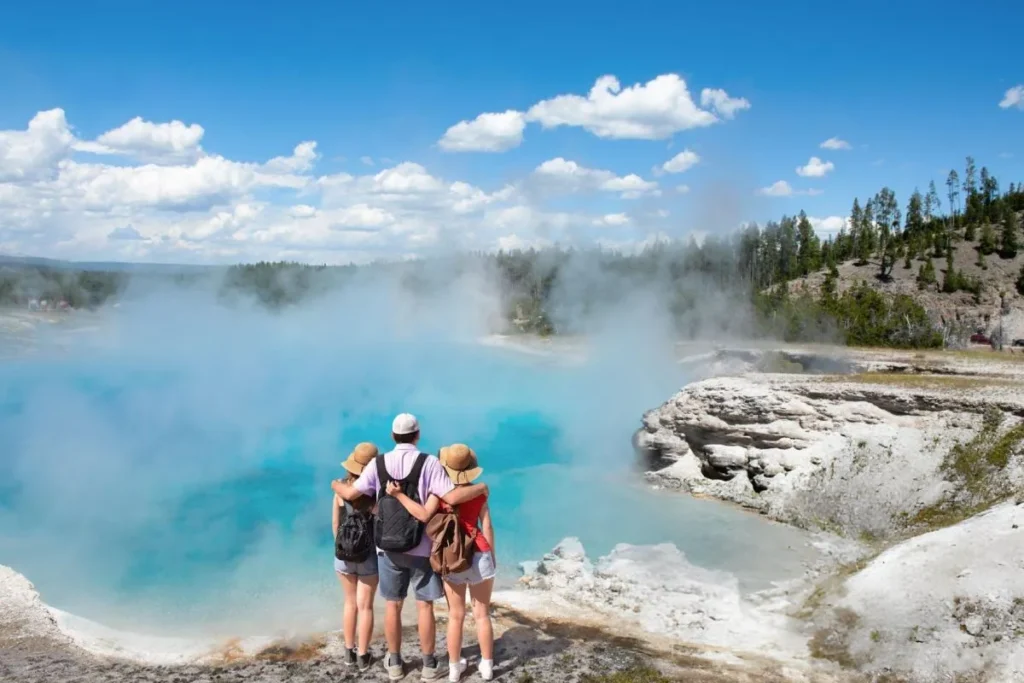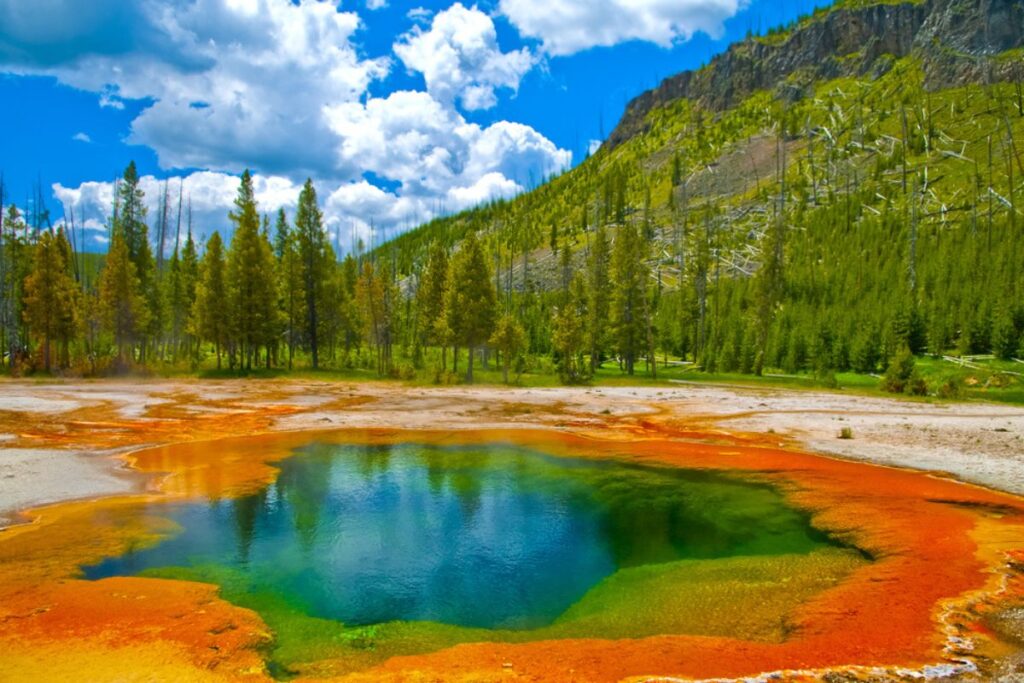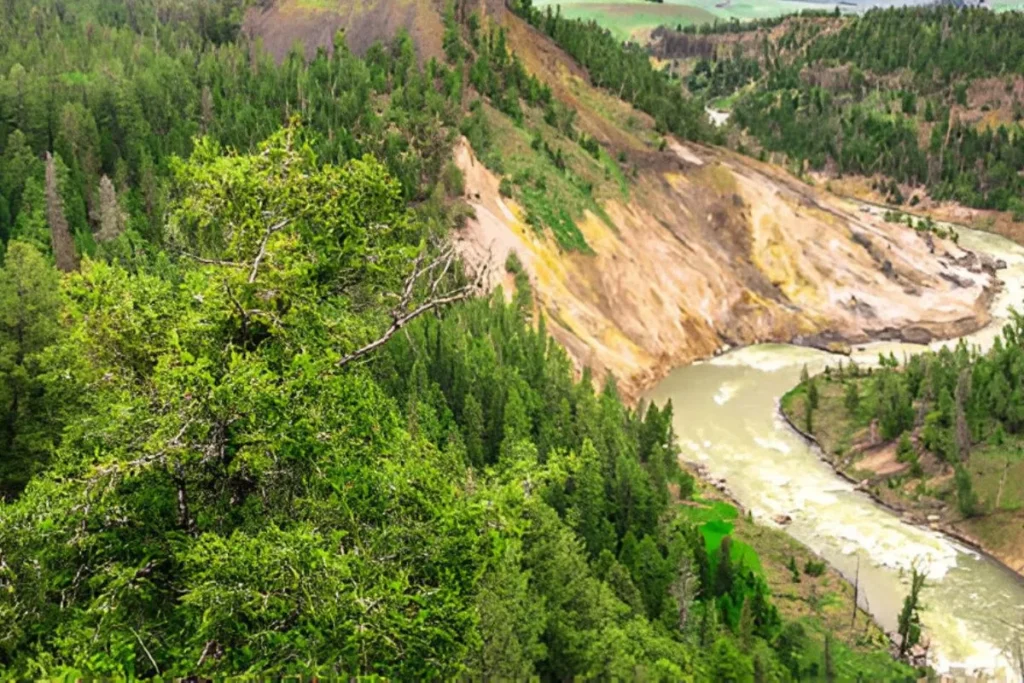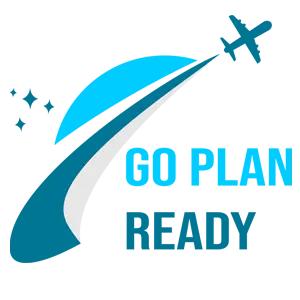Table of Contents
Yellowstone National Park, a crown jewel of the American wilderness, beckons travelers with its geothermal wonders, awe-inspiring landscapes, and diverse wildlife. But amidst the excitement of planning your trip, a crucial question arises: when is the best time to visit Yellowstone National Park?
This detailed guide, made especially for tourists on a budget, goes into detail about the differences between each season to help you pick the best time for an amazing (and cheap!) Yellowstone trip.
Yellowstone’s Allure: A Year-Round Wonderland
It doesn’t matter what season it is in Yellowstone National Park. Wildflowers bloom in the fields in the spring, and geysers explode with new energy after a long winter sleep. During the summer, the park becomes a hiking lover’s dream, with lush trails going to famous sites like Grand Prismatic Spring and Old Faithful. In the fall, the leaves turn red, making the scenery beautiful and making it easy to see wildlife. Cross-country walkers and snowmobilers can get away from it all in the winter, when the snow is clean and white.
A Deep Dive into Yellowstone’s Seasons:
Spring (April-May):
- Weather: Spring is a time of change in Yellowstone. Weather will be warm, with temperatures usually in the 40s and 50s Fahrenheit (4°C to 15°C). Spring showers are possible. Some roads may be closed temporarily when snow melts, especially at higher levels. Because the weather is always changing, bring clothes..
- Crowds: Spring is a more quiet time than summer, when there are a lot of people. Walking tracks and famous tourist spots will have fewer people.
- Activities: Spring is a great time to see wildlife. Watch the beauty of baby bison playing in the fields or elk waking up from their winter sleep. During this time, ranger-led events that teach visitors about the park’s past and ecology often start up again. Watch out for unique spring events like photography classes or walks with a guide to see wildflowers.
- Costs: Going to Yellowstone in the spring can be a good way to save money. It’s possible that hotel, cabin, and campground prices will be lower than during the busy season. This means that you may be able to find deals on lodging.
Insider Tips for Spring Travelers:
- Pack rain gear and versatile clothing: Get ready for the chance of spring rain. Putting on layers will help you deal with the changing weather.
- Research road closures: Check the website of the National Park Service to see if any roads are closed temporarily because of melting snow.
- Book lodging in advance: Although there are fewer people, popular places to stay can still fill up quickly, especially on weekends.
- Bring binoculars: Since spring is a great time to see wildlife, binoculars will make your experience better.
Summer (June-August):
- Weather: Yellowstone’s hottest season is summer, when temps range from the 60s to the 80s Fahrenheit (15 to 27°C). Thunderstorms often happen in the afternoon, so bring a small rain jacket with you.
- Crowds: Get ready, because summer is Yellowstone’s busiest season, with lots of people visiting. You can expect longer lines at famous spots and busier roads.
- Activities: There are most things to do in Yellowstone during the summer. People who like to hike can go on well-known paths like the Old Faithful Upper Geyser Trail or find secret gems like the Mystic Falls Trail. When you’re camping, you can really get into the experience under the stars. In the park, there are many lakes and rivers where people can fish. There are also a lot of fun ranger-led programs in the summer, like guided walks, geology talks, and educational programs for kids.
- Costs: The most expensive times to stay and go on tours are in the summer. Also, be ready for prices to go up at park eateries.
Insider Tips for Summer Travelers:
- Book accommodations well in advance: In the summer, popular places to stay quickly fill up. You can get the best deals if you plan your trip and book your stay early.
- Arrive early at popular attractions: Early in the morning is the best time to get to famous geyser basins and views to avoid crowds.
- Explore during off-peak hours: Consider going to hot spots when there are fewer people there, like early in the morning or late at night.
- Pack for the sun: Don’t forget to bring a hat, sunglasses, and sunscreen for the summer.
Fall (September-October):
- Weather: It’s nice to slow down in the fall. The temperatures drop, ranging from the 40s to the 60s Fahrenheit (4°C to 15°C). The mornings are cool and the afternoons are pleasant. Be ready for the chance that higher areas will get snow early.
- Crowds: When compared to summer, fall is calmer and there are fewer people around. However, weekends and holidays can still see a surge in visitors.
- Activities: Fall is a great time for photographers. With the contrast of the golden aspens and the evergreens, the scenery turns into a painting of bright colors. As you drive along the Lower Loop or the Grand Loop Road, the views are stunning. The wildlife watching is still great, and now is elk rutting season, when you can see their amazing shows. During the fall, photography classes often take advantage of the beautiful leaves and teach participants how to take great pictures of park views.
Insider Tips for Fall Travelers:
- Pack layers: The weather in the fall is hard to predict, so bring clothes to keep warm or cool.
- Check road conditions: Keep in mind that roads may be closed if it snows early at higher levels.
- Consider camping: Although some sites may close for the season, a lot of them stay open all fall. Camping is an inexpensive way to see the fall colors.
- Bring a camera with a zoom lens: This is the best time of year to see fall colors and wildlife. You can get clear pictures of these times if you have a camera with a zoom lens.
Winter (November-March):
- Weather: When winter comes, Yellowstone turns into a snowy beauty. The temperature drops, and it often gets below freezing (0°C), and a lot of snow falls. The park is least busy in the winter, when many of the roads and amenities are closed.
- Crowds: Winter is the best time to visit Yellowstone because there are fewer people there. Get ready for a truly independent journey in the snowy settings.
- Activities: Winter offers unique adventures for tourists who like to try new things. Go on exciting snowmobile tours through the pristine backwoods and check out secret geothermal features that you can’t get to any other time of the year. When you cross-country ski, you can enjoy the snow-covered paths without disturbing anyone. Seeing wildlife in the winter takes care and the right gear, but skilled tourists can find bison, elk, and wolves in the snow. There aren’t many ranger-led programs in the winter, but there might be some that focus on winter wildlife or lead walking trips.
Insider Tips for Winter Travelers:
- Rent appropriate winter gear: You need special gear to go snowmobiling and cross-country skis. You can do these things without spending a lot of money on gear by renting it.
- Prioritize safety: Because of the weather, winter requires proper planning. Wear layers of warm clothes and boots that won’t get wet, and check the weather before you go outside.
- Book snowmobile tours well in advance: A lot of people like to go snowmobiling in the winter, and groups can get full very fast.
- Be prepared for limited services: During the winter, a lot of parks and restaurants are closed. Get food and other things you might need before you go to the park.
Tailoring Your Yellowstone Trip: Catering to Different Budgets

People who are trying to stay within their trip budgets want to find cheap ways to see Yellowstone. Here are some tips for planning the best trip for your budget:
- Spring and Fall: This is a great time to travel on a budget during these vacation seasons. You might be able to find cheaper lodging than in the summer, and there will be fewer people around.
- Camping: Camping in Yellowstone is one of the least expensive ways to see the park. There are many sites in the park, and they all have different prices and services.
- Free Activities: There are many free things to do in Yellowstone National Park. Hike along beautiful trails, be amazed by natural wonders like Old Faithful and Grand Prismatic Spring, and check out the park’s tourist centers, which are full of interesting displays.
- Bring Your Own Food: If you pack your own meals and drinks, you can save a lot of money on food while you’re traveling. Before going into the park, you might want to do some food shopping in a nearby town.
- Look for Park Pass Deals: The National Park Service Interagency Pass is good for one year and lets you into Yellowstone and other government leisure areas. For people who want to see a lot of parks in a year, this pass might be the best deal.
Preparing Your Yellowstone Expedition besides the Seasons

- Accommodation: There are many places to stay in Yellowstone, from cheap campgrounds to famous hotels. When making your choice, think about how comfortable you want to be, what services you want, and how close you want to be to park activities.
- Transportation: Taking a car is the best way to see Yellowstone. If you are coming by plane, you might want to take a car or go on an organized tour that includes getting around the park.
- Park Fees: The fee to enter the park stays the same all year. If you want to visit more than one national park in a year, you might want to buy a yearly pass.
- Packing Essentials: Prepare your bags for the season you’ll be visiting. No matter the season, you must have strong hiking boots, comfy clothes, a water bottle that you can use again and again, sunscreen, and bug spray. Layer up because the weather can change quickly.
Leave No Trace Principles for Environmental Respect

Yellowstone National Park has a unique environment that is full of living things. If you want to leave the park looking nice for future generations, it’s important to follow the Leave No Trace rules when you’re there. Here are some important rules to keep in mind:
- Plan Ahead and Prepare: Find out about park rules and closings before you go. Pack the right gear and food to cut down on waste.
- Travel and Camp on Durable Surfaces: Stay on paths and spots that have been marked so that you don’t damage plants and animals’ homes.
- Dispose of Waste Properly: Throw away all of your trash, including used tissues, food scraps, and personal care items. Don’t leave any signs of your stay.
- Leave What You Find: The park takes care of both natural and culture objects. Don’t touch rocks, trees, or historical items; let other people enjoy them.
- Respect Wildlife: Keep your distance from all animals. You should never feed animals because it can change how they normally act and put them in danger.
- Minimize Campfire Impacts: Only use the fire rings that are marked, and put out all fires before you leave.
- Be Considerate of Other Visitors: Keep the noise level down and be polite on walks and views so that other people can enjoy their peace and quiet.
How to Get the Most Out of Your Yellowstone Adventure

Now that you know when to go to Yellowstone based on your income and tastes, here are some more tips to make sure you have a great time:
- Download the Official App: The National Park Service app is helpful because it has maps, routes, descriptions of trails, and plans for ranger-led programs.
- Explore Beyond Popular Attractions: You have to see Old Faithful and Grand Prismatic Spring, but don’t stop at just those two. Visit geyser pools, waterfalls, and overlooks with great views that not many people know about to find the park’s secret gems.
- Embrace the Unexpected: Yellowstone National Park is a place that changes all the time. Be ready for changes in the weather and wildlife you didn’t expect to see. Keep your sense of excitement and be ready for unplanned side trips.
- Learn About the Park’s History and Ecology: Visit park tourist centers and go to programs run by park rangers to learn more about Yellowstone’s history. Knowing about the park’s history, geothermal action, and wide range of wildlife will make your visit more enjoyable.
- Capture Memories Responsibly: Take care with your camera to get beautiful pictures and movies. Don’t bother wildlife or get in the way of other tourists’ views.
- Disconnect to Reconnect: In today’s digital world, you might want to limit how much you use your phone while you’re away. Enjoy the natural beauty of the park and take a break to get back in touch with yourself and nature.
Exploring the Greater Yellowstone Ecosystem: Going Beyond Yellowstone
There are many parts to the Greater Yellowstone Ecosystem, and Yellowstone National Park is only one of them. Think about going outside the park to explore national parks and woods that are close by:
- Grand Teton National Park: Grand Teton National Park has beautiful views and great hiking options. It has huge mountain ranges and clear lakes.
- Grand Teton National Forest: The National Forest surrounds Grand Teton National Park and has a variety of scenery where you can camp, fish, and watch wildlife.
- John D. Rockefeller Jr. Memorial Parkway: This beautiful road links Yellowstone and Grand Teton National Parks and offers amazing views and chances to see wildlife.
Conclusion: Unforgettable Adventures Await
Nature, volcanic features, and stunning scenery all make Yellowstone National Park very appealing. You can plan the perfect trip and have an amazing experience by thinking about your income and personal tastes. Remember that treating Yellowstone’s environment with care and enjoying its fragile balance is what makes it magical. Prepare to make experiences that will last a lifetime by bringing your sense of adventure and following the Leave No Trace rules.
Bonus Resources:
- National Park Service – Yellowstone National Park: https://www.nps.gov/yell/
- Yellowstone National Park Lodges: https://www.yellowstonenationalpark.com/yellowstonelodging.htm
- Interagency Annual Pass: https://store.usgs.gov/recreational-passes
- Leave No Trace Center for Outdoor Ethics: https://lnt.org/why/
This complete guide gives you all the information and tools you need to plan a cheap Yellowstone trip. Let Go Plan Ready help you make your Yellowstone dreams come true!
Frequently Asked Questions about Visiting Yellowstone National Park on a Budget:
When is the cheapest time to visit Yellowstone?
Generally, spring (April-May) and fall (September-October) offer the most affordable options compared to peak summer. You might find lower accommodation rates and fewer crowds during these shoulder seasons.
What are the most budget-friendly ways to stay in Yellowstone?
Camping is the most cost-effective way to stay within the park. Yellowstone offers numerous campgrounds with varying amenities and price points. Consider staying in nearby towns outside the park for potentially cheaper lodging options.
How can I save money on food while visiting Yellowstone?
Packing your own meals and snacks can significantly reduce your food expenses. Stock up on groceries in nearby towns before entering the park. Take advantage of free grills often available at campgrounds to cook your own meals.
What are some free activities I can enjoy in Yellowstone?
Yellowstone boasts a wealth of free activities! Hike on scenic trails, marvel at the geothermal wonders like Old Faithful and Grand Prismatic Spring, and explore the park’s visitor centers filled with informative exhibits. Ranger-led programs often offer free educational talks on the park’s ecology and history.
What do I absolutely need to pack for Yellowstone?
Sturdy hiking boots are essential for exploring the park’s trails. Pack comfortable clothing for the specific season you’re visiting. Regardless of the season, bring layers for unpredictable weather changes. Don’t forget a reusable water bottle, sunscreen, and insect repellent.
Are there any discounts available on park entrance fees?
The standard park entrance fee applies year-round. However, consider purchasing an annual National Park Service Interagency Pass if you plan on visiting multiple parks within a year. This pass grants access to Yellowstone and other federal recreation lands for a year at a discounted rate.
What are some things I should avoid doing in Yellowstone?
- Feeding wildlife: This alters their natural behavior and puts them at risk.
- Leaving trash: Pack out all trash, including food scraps and hygiene products.
- Going off designated trails: This damages vegetation and wildlife habitat.
- Getting too close to wildlife: Maintain a safe distance for your safety and the animals’ well-being.
- Speeding: Observe posted speed limits to ensure your safety and minimize wildlife encounters.
I’m traveling solo, is Yellowstone safe for solo travelers?
Yellowstone National Park is generally safe for solo travelers. However, always practice common sense safety precautions. Be aware of your surroundings, inform someone of your itinerary, and stick to designated trails, especially during hikes.

